This guide is intended to show people how to pack Lladro and other figurines and fragile items so that they survive shipping and arrive safely and unbroken. These porcelain figurines stand up to twenty inches tall, eighteen inches wide, and six inches deep with all sorts of tiny leaves, flowers, and figures attached.
These figurines are difficult enough to send in their original box, but if you don’t have a box, they can be a nightmare. After a lot of research I combined several ideas and came up with a method of shipping these figurines, and other items equally fragile, without them getting broken in transit.
When you are packing something this fragile, with lots of stress areas, you must stand back and look at the item long and hard and try to figure out what could break, how it could break, and what would cause the stress on it. Take your time with this, do not hurry. This is the most important part.
Next, you must figure out what you will need to do and what materials you will need to have in order to protect those fragile areas and stress points so that they do not get damaged or damage other parts of the item.
Once you have determined what stress areas there are and what you need to protect them, you are ready to assemble your materials. Do Not start until you have all your materials assembled.
Be aware, packing an item like the one I am about to show you will take most of a day. Do not be afraid to charge for packing. Anyone who is willing to pay what these items are worth will be happy to pay for proper packing to assure a safe delivery.
Packing Materials List
- Strapping tape. The kind with strands of fibers embedded inside
- Blue painters tape
- Clear packaging tape
- Toilet paper, very soft
- Nylon twine
- A package of wooden skewers
- Medium bubble wrap
- Packing peanuts
- A piece of one-half inch plywood cut to the size of the bottom of your inner box – exactly
- 1 inch rigid foam insulation sheets. 1 or 2 4×8 sheets will do depending on the size of your item and your box
- A drill
- A saw, preferably a circular saw. NOTE: If you don’t have a saw, you can measure the bottom of the box and have the lumberyard cut the wood for you.
- Cut a piece of the foam the same size as the wood.
- A glue gun or other type of glue
- Scissors
- Box cutter
- Two heavy duty boxes one about 3 inches larger than your figurine on the sides and top and one about three inches larger than the first one on all sides including the top and bottom.
You are probably wondering why you need some of the materials on this list. It will become clear as you go through the process.
Packing Steps
Assemble your smaller box. You might have to cut it down to size to be about three inches larger than the figurine on all sides and the top. Make sure it is the correct size before you tape the bottom.
Cut the plywood to fit, exactly, in the bottom of the box. NOTE: If you don’t have a saw, you can measure the bottom of the box and have the lumberyard cut the wood for you.
Use the box cutter and cut a piece of the insulation foam exactly the same size as the wood.
Place the foam on the wood and then place your figurine on top of the foam. Position it so that none of the edges are less than 3 inches from the edge of the foam. Trace the bottom of the figurine on the foam. Take the figurine off and cut out the area you traced. You will now have a piece of foam with a hole in it the same shape as the bottom of the figurine.
Test the size of the hole by placing the figurine in the hole. It should fit snuggly and no piece of the figurine should be stressed. You may have to make some minor adjustments to the hole so the figurine sits all the way down to the wood.
Take the figurine out of the hole and glue the foam to the board.
Now you will protect the fragile elements of the figurine.
Take toilet paper and wad it, do not wrap it, and place it against fragile pieces on the figurine. Secure it with the blue painters tape, do not use any other type of tape. Continue to do this until all of the fragile pieces are cushioned and secured.
You will now determine where you will place the ties that secure the figurine to the board. You will be placing two or three spans of twine across the base and through holes in the board to hold the figurine in place.
Place the figurine in the hole and press it down to the board. Look at where you can place twine ties across the base of the figurine to hold it down. You will want to have two or three spans of twine to hold the figurine in place and mark the spots
Take the figurine out of the hole and drill holes where you marked. There should be two holes for each span of twine.
Place the figurine in the hole. Cut a piece of twine and thread it up from the bottom of the board, over the base of the figurine, and down the opposite hole. Do this two or three times. I use one of the skewers as a sort of needle to push the twine through the hole.
With someone holding the figurine and the base, tilt the base and tie the twine under the board as tight as you can. Take one of the wooden skewer sticks, break it in half, and use it to twist the twine under the board until it is very tight. Secure the skewer with tape so it does not unwind. Repeat the last 4 steps for the rest of the spans.
Time to put it in the box
Place the base with the secured figurine in the smaller box.
Carefully wrap bubble wrap around each segment of the figurine. DO NOT wrap any two elements together.
Cut two pieces of foam insulation to the exact size of two opposite sides of the box. There will be a top piece of foam so be sure to leave enough room at the top to put a foam cap on.
Place the two side pieces in the box so that they fit exactly side to side and from the top of the board to the top of the box, less the amount of space needed for the top piece of foam.
Now for some examples of really good packing.
First example:
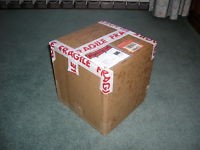
A good size sturdy box, well taped with “Fragile” tape, you can see box got slightly wet on the day of delivery which was no problem.
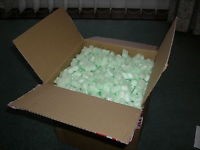
The box was filled with good quality polystyrene chips.
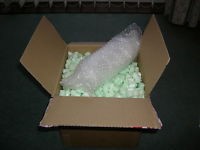
The bubble wrapped figurine was found in the center of the polystyrene chips.
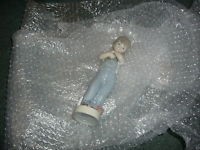
A perfect undamaged figure.
Second example:
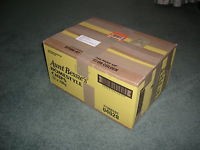
A good strong box.
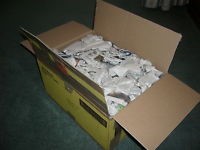
The box was stuffed with plenty of paper which was good enough to hold the figure in the center of the box.

The figure was well bubble wrapped; expanded polystyrene has been cut and used to hold the figure in the center of the box. The seller had even constructed a polystyrene base for the figure to offer even more protection and support.
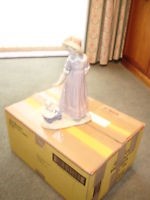
A perfect undamaged piece.
I hope these examples have given you plenty ideas of good and bad packing.
An additional word of warning – I have seen some sellers who say they will not take responsibility for the transit of their items. They will say things like, they will support the seller in a claim. Claiming on insurance doesn’t work like that – the seller has to make the claim. Do not buy from any seller that negates their responsibility for customer service.
Top Tips:
1. Use a good sturdy large box and use plenty of quality filling, preferably polystyrene chips.
2. If using the older type of original Lladro box make sure the figure is secured using the cardboard and tape, then fill with tissue paper (or another suitable soft filler). Make sure the piece can’t move.
3. If you have no box make sure the figure is well wrapped in bubble wrap and that this is taped.
4. Ensure the original Lladro box or wrapped figure is in the in the centre of the bigger box. If possible use expanded polystyrene to hold it in the center.
5. Test for any movement within the inner and outer boxes.
6. Only post the item if you feel 100% confident it will protect the figure.
7. Remember a small box (like a shoe box) is absolutely of no use. Small boxes will be thrown around, like passing a rugby ball – think of bigger boxes, they don’t tend to be thrown around so often and are more likely to be picked up and placed.
8. Make sure that there is insurance on transit of the item.
9. Do not buy from any seller who says they will not take responsibility for the safe transit of an item or suggests that any claim will be for the buyer to pursue.
10. Let a seller know if think their packing was not good, even if the figure survives the journey.



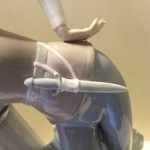


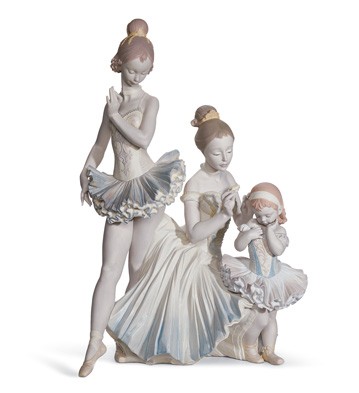
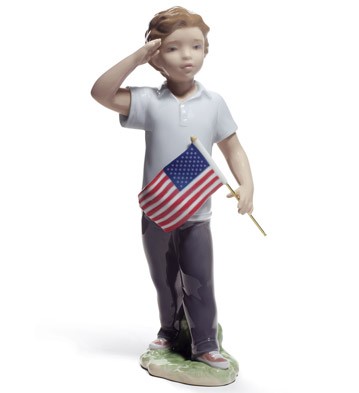

Leave a Reply